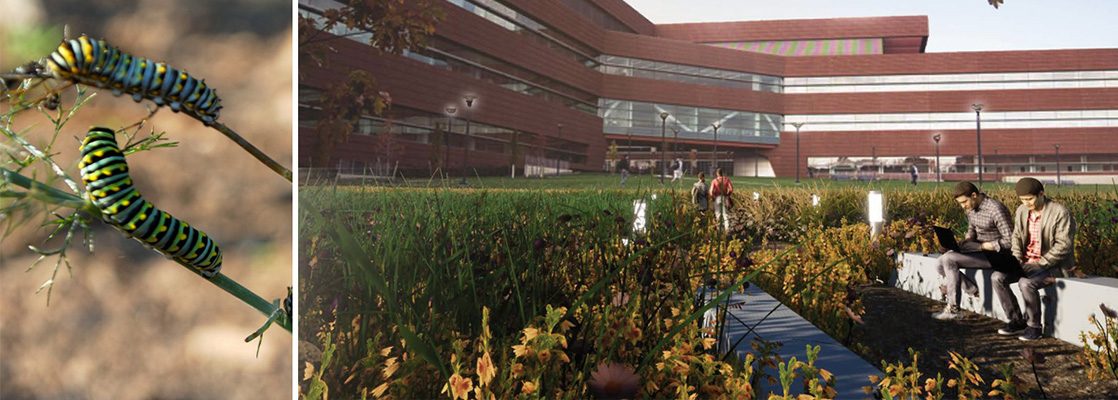Module 4: Planted Pollinator Meadow

Module 4 focuses on the Planted Pollinator Meadow component of the Millennium Science Complex initiative, keeping the site’s overall goals and program in mind (please revisit the Planting Objectives, Program, and Guidelines provided at the beginning of the semester on Canvas). Module 4 comprises two sub-modules:
- Module 4a Meadow Palette and Concept, and
- Module 4b Technical Meadow Plan, Schedules, and Establishment Notes.
Recall that the Planted Pollinator Meadow was introduced in the Planting Goal, Objectives, and Program. In particular:
The Planted Pollinator Meadow is a planted herbaceous community that replaces the Millennium Science Complex’s vast, poorly used, and decidedly unsustainable turfed plateau. It demonstrates graminoids (mostly grasses, but also some sedges and rushes) and perennial wildflowers (‘forbs’) and their accompanying ecologies. The new, mostly self-sustaining—but still managed—plant community will serve as a learning environment for students, faculty, and visitors exploring meadow ecology, the essential roles of diverse pollinators, and establishment techniques. It should also be a pleasant and inspiring place to experience a richly textured, colorful, and animated setting close at hand.
Grasses will form the ‘backbone’ of the meadow complex since wildflower-only plantings tend to get spindly and turn weedy quickly. Two primary categories of grasses tend to dominate natural grasslands: warm-season (mostly midwest and southern U.S.) and cool-season (mostly northeast and northwest U.S.) We will not intermix warm- and cool-season grass meadows because they demand differing establishment approaches, even though in natural settings they will often co-mingle.
What will begin as a plant assemblage will, hopefully, become a largely self-sufficient habitat that only requires periodic management informed by regular monitoring.
So, the planted pollinator meadow ecosystem envisioned for much of the currently turfed area of Millennium Science Complex will be an herbaceous complex demonstrating mixed graminoid and forb communities. Once well-established in 3-4 years, this mostly self-sustaining installation will serve as a learning environment for students, faculty, staff, and visitors exploring ecology, pollinator habitat, and associated techniques. As importantly, it should also be a pleasant – even recuperative and inspiring – place to experience a vibrant and richly textured setting close at hand.
While some of the meadow’s experience will be from along the existing perimeter sidewalks and even visually from surrounding buildings, the primary means of experiencing it will be via both the existing cross-meadow walkways and a new, more informal unpaved path system that allows pedestrians to immerse themselves in the meadow. Recalling our Module 1a analysis, your solutions should consider soil, microclimatic, landform, spatial, ecological, social, and functional conditions in and around the site.
Learning Objectives
- Create a well-crafted seeded and plugged meadow plan and plant schedule (AutoCAD and Excel)
- Gain experience in the horticulture and ‘ecoculture’ of established and emerging planting genres—the mixed pollinator garden, treed urban plaza, meadow and hydric habitats, and other planted landscape contexts;
- Build technical abilities in species selection, planting establishment and soil improvement methods, planting installation details, and adaptive management of the planted landscape; and
- Build technical construction, contractor note skills for site preperation, installation, and management to ensure a successful planted meadow ecosystem.
Wetland Indicator Resources
Reference Resources
Crain, R. 2017. The Power of the Palette: A Tool to Guide Planting Decisions. http://content.yardmap.org/learn/planting-palettes/
Dept. of Entomology 2016. Bees, Bugs & Blooms – A pollinator trial. Penn State, https://ento.psu.edu/news/bees-bugs-blooms-2013-a-pollinator-trial
Dept. of Entomology, Step 3: Provide Shelter (pollinator habitat). Penn State University, https://ento.psu.edu/research/centers/pollinators/public-outreach/cert/cert-steps-step3
Ernst Seed catalog, 2022-2023. http://www.ernstseed.com/contact-us/catalog
Ernst Seed’s “Seed Finder Tool” https://www.ernstseed.com/seed-finder-tool/
Garneau, T. et al., Conserving Wild Bees in Pennsylvania. https://extension.psu.edu/conserving-wild-bees-in-pennsylvania
Mid-Atlantic Native Plant Farm, Inc. (online nursery catalogue; good for plug trays and bare-root perennial stock) https://midatlanticnatives.com/
Heller, S. et al., 2019. Diversified Floral Resource Plantings Support Bee Communities after Apple Bloom in Commercial Orchards, Scientific reports, 9: 17232, https://www.nature.com/articles/s41598-019-52601-y
Laughlin, D. and C. Uhl. 2003. The Xeric limestone prairies of Pennsylvania. (on Canvas)
Minnestoa Stormwater Manual: Erosion prevention practices / erosion control blankets and anchoring devices https://stormwater.pca.state.mn.us/index.php/Erosion_prevention_practices_-_erosion_control_blankets_and_anchoring_devices
New Moon Nursery:
Native Perennials. http://www.newmoonnursery.com/Perennials
Grasses. http://www.newmoonnursery.com/index.cfm
Stormwater Management, Rain Gardens http://www.newmoonnursery.com/index.cfm/fuseaction/plants.main/alphaKey/J-L/typeID/8/index.htm and http://www.newmoonnursery.com/index.cfm
North Creek Nursery (good for plugs): https://www.northcreeknurseries.com/
Pollinator Partnership and NAPPC. Selecting Plants for Pollinators: Central Appalachian Broadleaf Forest. www.pollinator.org/PDFs/Guides/CentralAppalachianrx7FINAL.pdf
Prairie Nursery Native Plants and Seeds–
Native Wildflowers. https://www.prairienursery.com/store/native-wildflowers
Native Grasses. https://www.prairienursery.com/store/native-grasses
Prairie Moon Nursery: https://www.prairiemoon.com/
Surcică, A. et al., Pollinator Food., Dept. of Entomology, Penn State, https://ento.psu.edu/files/pollinatorfood/view
Sylva Native Plant Nursery / Wet Meadow species (good for plugs): http://www.sylvanative.com/native-wildflowers-native-ferns/native-wildflowers-ferns.htm
Tallamy, Doug. Bringing Nature Home website, http://www.bringingnaturehome.net/
U.S. Army Corps of Engineers. 2016. Eastern Mountains and Piedmont 2016 Regional Wetland Plant List + North Central and Northesast 2016 Regional Wetland Plant List (PDF on Canvas)
Xerces Society. 2020. Pollinator-Friendly Native Plant Lists. https://xerces.org/pollinator-conservation/pollinator-friendly-plant-lists
Zuberbuhler, B. Wildflowers of western Pennsylvania. http://www.westernpawildflowers.com/ https://ento.psu.edu/news/bees-bugs-blooms-2013-a-pollinator-trial
Other Helpful References
Bowman’s Hill Wildflower Preserve: http://www.bhwp.org/
Chamberlain, S. 2018. Field guide to grasses of the Mid-Atlantic. (I have a copy)
Ernst Seeds – Stormawter Management Planting Guide: https://www.ernstseed.com/resources/planting-guides/stormwater-management-planting-guide/
Erosion control products (for Rain Meadow):
https://acfenvironmental.com/wp-content/uploads/2015/09/B.4ECBs-Brochure-Single-Net-Straw.pdf
https://acfenvironmental.com/products/erosion-control/temporary-erosion-control/short-term-ecb/
https://www.erosioncontrol-products.com/erosioncontrolblanket.html
https://www.erosioncontrol-products.com/landscapestakes.html
https://nagreen.com/sites/default/files/2020-07/EC_RMX_MPDS_S75BN_7.20.pdf
https://nagreen.com/sites/default/files/2018-02/EC_GEN_MPDS_EcoStake_4.17.pdf
Illinois Wildflowers: grasses: http://www.illinoiswildflowers.info/grasses/grass_index.htm
forbs: http://www.illinoiswildflowers.info/index.htm
Ohio Prairie Nursery: http://www.ohioprairienursery.com/
Penn State Extension. 2015. Landscaping to attract beneficial insects. https://extension.psu.edu/landscaping-to-attract-and-conserve-beneficial-insects
Sylva Native Nursery and Seed Co.: http://www.sylvanative.com/
U.S. Wildflower’s Database of Wildflowers for Pennsylvania: https://uswildflowers.com/wfquery.php?State=PA
Zimmerman, E., et. al. 2012. Terrestrial and Palustrine Plant Communities of Pennsylvania, 2nd Edition. Pennsylvania Department of Conservation and Natural Resources. http://www.naturalheritage.state.pa.us/Communities.aspx
